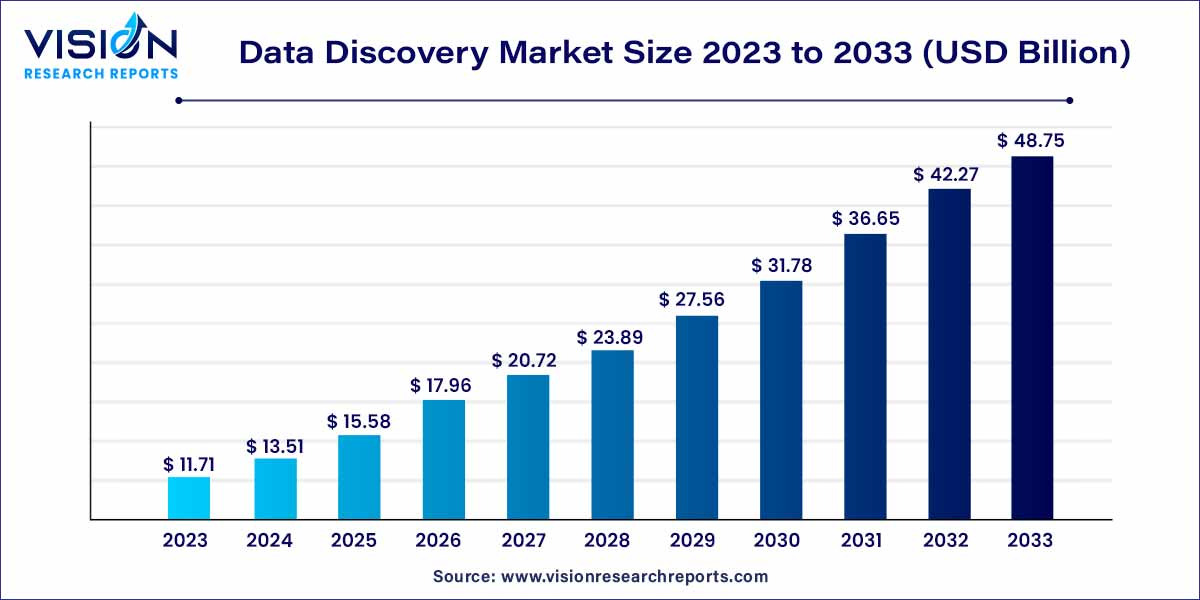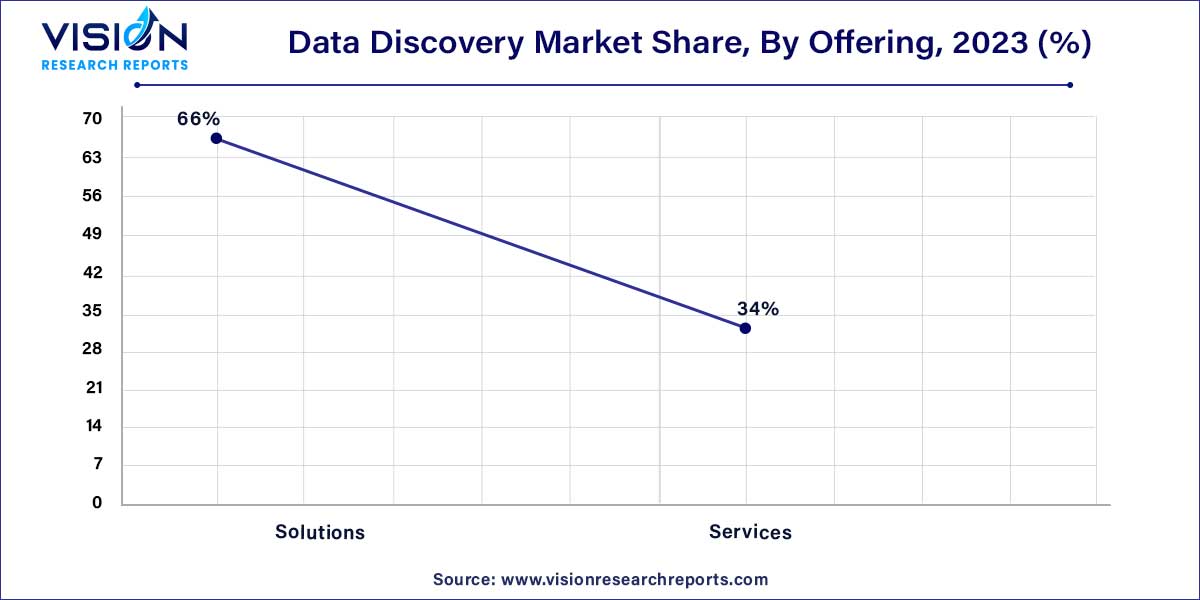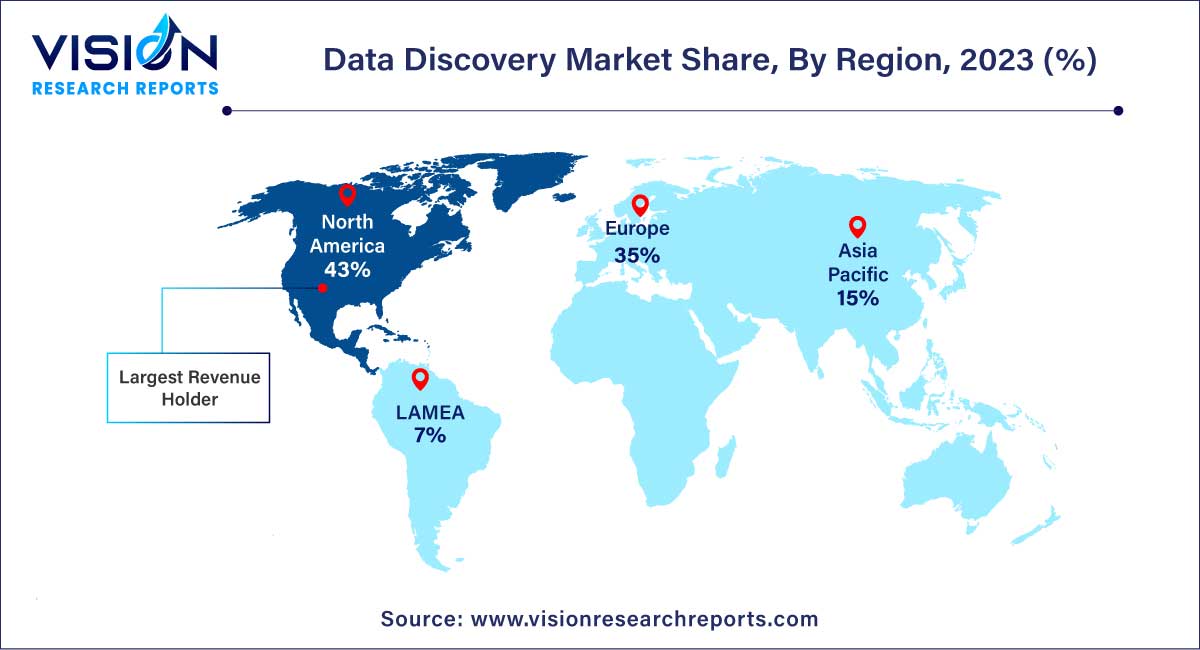The global data discovery market size was estimated at around USD 11.71 billion in 2023 and it is projected to hit around USD 48.75 billion by 2033, growing at a CAGR of 15.33% from 2024 to 2033.

In the burgeoning landscape of data discovery, several factors converge to fuel its remarkable growth. Firstly, the exponential increase in data generation across industries, commonly referred to as big data, acts as a catalyst. Organizations are compelled to seek sophisticated solutions to sift through vast datasets and extract meaningful insights. Additionally, the growing emphasis on data-driven decision-making underscores the importance of tools that facilitate the discovery and interpretation of relevant information. The democratization of data within organizations, with an increasing number of users requiring access to and understanding of data, propels the demand for intuitive data discovery platforms. Moreover, advancements in artificial intelligence and machine learning contribute to the market's expansion by enhancing the analytical capabilities of these tools. As businesses recognize the pivotal role data plays in gaining a competitive edge, the data discovery market continues to evolve, driven by a confluence of factors that signify its pivotal role in the digital era.
| Report Coverage | Details |
| Market Revenue by 2033 | USD 48.75 billion |
| Growth Rate from 2024 to 2033 | CAGR of 15.33% |
| Revenue Share of North America in 2023 | 43% |
| Base Year | 2023 |
| Forecast Period | 2024 to 2033 |
| Market Analysis (Terms Used) | Value (US$ Million/Billion) or (Volume/Units) |
The solutions segment led the market with a revenue share of 66% in 2023. The segment's growth is attributed to the comprehensive and integrated approach offered by data discovery solutions, encompassing data preparation, visualization, and analysis tools. Solutions exhibit scalability and customizability, making them particularly well-suited for large enterprises. Moreover, the escalating demand for data-driven decision-making, with businesses increasingly relying on data to enhance their performance, is driving the segment's growth in the market. Furthermore, the mounting complexity of data, which is growing in volume and becoming more unstructured, is addressed effectively by data discovery solutions, aiding businesses in comprehending and utilizing their data, regardless of its format or complexity.

The services segment is poised for significant growth over the forecast years. The services encompass both professional and managed services segments. Professional services segment includes consulting, implementation, training, and support, which aid organizations in selecting the right data discovery solution, deploying it effectively, and training their staff for proficient usage. Managed services segment involves outsourcing data discovery solution management and maintenance to third-party providers, relieving internal resources and allowing organizations to focus on core business activities. Furthermore, the services segment is fueled by the complexity of data environments, the demand for self-service data analysis, and the essential support and maintenance needed to ensure data discovery solutions work effectively in the evolving data challenges.
The on-premises segment contributed the largest market share of 55% in 2023. This dominance is attributed to several factors, including stringent security and compliance requirements that lead organizations to favor on-premises solutions for maintaining control over their data and infrastructure. On-premises deployments are highly adaptable, allowing customization to meet specific organizational data needs, which is particularly valuable for entities with intricate data requirements. In addition, on-premises deployments excel in providing superior performance in situations like real-time analytics, outperforming certain cloud-based alternatives.
The cloud segment is anticipated to witness substantial growth over the forecast period. The increasing adoption of cloud computing, favored by businesses of all sizes, is a significant driver, with more organizations transitioning their data and applications to the cloud, thereby elevating the demand for cloud-based data discovery solutions. The growing complexity of managing widely distributed cloud environments, where data and applications are spread across multiple providers and locations, has created a need for automated discovery and management. Cloud-based data discovery solutions address this challenge by providing a consolidated view of the data landscape. Moreover, cloud-based data discovery solutions can adapt to changing business needs, provide data access from any location at any time, and streamline deployment and management.
The security and risk management segment had the largest market share of 27% in 2023. The growth is attributed to the organizations' continued investments in data security and compliance. With the heightened awareness of safeguarding sensitive data against unauthorized access, theft, or loss, data discovery solutions have gained significance. They assist organizations in identifying and classifying sensitive data, evaluating data security risks, and implementing suitable risk mitigation measures. Moreover, with a growing emphasis on safeguarding sensitive data and meeting stringent regulations such as GDPR, HIPAA, and CCPA, data discovery solutions have become crucial for regulatory compliance and data protection.
Sales and marketing management segment is anticipated to witness significant CAGR over the forecast period. The increasing demand for data-driven decision-making across industries, associated with the escalating volume and complexity of data, highlights the need for businesses to identify trends and patterns within their data swiftly. Moreover, the rising adoption of cloud-based data discovery solutions has enhanced the ability of businesses to elevate their sales and marketing performance. This includes identifying new leads and prospects, more effective lead segmentation, precision in targeting marketing campaigns, accurate measurement of campaign effectiveness, and bolstering customer retention rates. Data discovery tools are becoming instrumental in empowering businesses to make data-driven, informed decisions that significantly impact their sales and marketing endeavors.
The BFSI segment led the market with a global revenue share of over 21% in 2023. The BFSI sector generates an immense volume of data, including customer information, transactions, and market data, and data discovery tools assist in extracting valuable insights from this data. Moreover, BFSI companies face growing regulatory compliance requirements, and data discovery tools aid in identifying and managing data risks to ensure adherence to relevant regulations. These tools also empower BFSI companies to harness data for better decision-making, identifying new opportunities, enhancing products and services, and reducing costs. They are instrumental in fraud detection, risk assessment, customer segmentation for targeted marketing, product development based on customer preferences, and improving operational efficiency by identifying and eliminating process inefficiencies. Thus, data discovery tools have become essential for BFSI companies in navigating their data, regulatory compliance, and strategic decision-making.
The healthcare sector is poised for substantial growth in the coming years. The escalating volume and complexity of healthcare data, encompassing electronic health records, medical imaging, and wearable device information, pose a significant challenge for healthcare organizations. Data discovery tools are becoming pivotal in aiding these organizations to identify and unify their scattered data, facilitating better insights and enhanced patient care. The increasing demand for value-based care models, which emphasize delivering high-quality care at reduced costs, is propelling the use of data discovery tools to identify efficiency improvements and cost reductions. Furthermore, the adoption of artificial intelligence (AI) and machine learning (ML) in healthcare applications, such as predictive analytics and personalized medicine, is on the rise. Data discovery tools are crucial for enabling these applications by providing access to the extensive and complex datasets required for training AI and ML models, contributing to improved patient outcomes and healthcare innovations.
North America dominated the market with a revenue share of over 43% in 2023. The region's growth is attributed to the substantial presence of large enterprises known for their early adoption of innovative technologies such as data discovery. North America region also experiences a widespread surge in the demand for data-driven decision-making, cutting across diverse industries. Furthermore, a growing awareness of the essential value of data and the necessity for effective data management is contributing to the region's dominance. For instance, in November 2022, Wiz, Inc., a U.S.-based cloud security platform provider, expanded its partnership with BigID, a leading data platform aimed at enhancing visibility and control over enterprise data to prevent breaches. This collaboration combines Wiz, Inc's Cloud-Native Application Protection (CNAPP) platform with BigID's Data Security Posture Management (DSPM) platform, offering customers a comprehensive solution that addresses both cloud security and data protection needs.

Asia Pacific region is anticipated to register the fastest CAGR over the forecast period, driven by a surge in digital transformation initiatives across various industries in the region. The adoption of digital technologies by businesses in Asia Pacific has led to a surge in data generation, necessitating effective data management and analysis. Data discovery tools play a pivotal role by automating the process of locating and comprehending data. Substantial investments in IT infrastructure, including cloud computing and data centers, have made it more accessible and cost-effective for businesses to handle vast amounts of data, spurring the adoption of data discovery tools. The proliferation of e-commerce, digital services, and government-led data-driven projects contributes to the need for data discovery tools, particularly in improving customer experiences, developing products and services, and facilitating better decision-making. Moreover, industries such as finance, healthcare, manufacturing, and education actively embrace data discovery to enhance decision-making, gain competitive advantages, and enhance operational efficiency.
By Offering
By Deployment
By Application
By End-use Industry
By Region
Chapter 1. Introduction
1.1. Research Objective
1.2. Scope of the Study
1.3. Definition
Chapter 2. Research Methodology
2.1. Research Approach
2.2. Data Sources
2.3. Assumptions & Limitations
Chapter 3. Executive Summary
3.1. Market Snapshot
Chapter 4. Market Variables and Scope
4.1. Introduction
4.2. Market Classification and Scope
4.3. Industry Value Chain Analysis
4.3.1. Raw Material Procurement Analysis
4.3.2. Sales and Distribution Channel Analysis
4.3.3. Downstream Buyer Analysis
Chapter 5. COVID 19 Impact on Data Discovery Market
5.1. COVID-19 Landscape: Data Discovery Industry Impact
5.2. COVID 19 - Impact Assessment for the Industry
5.3. COVID 19 Impact: Global Major Government Policy
5.4. Market Trends and Opportunities in the COVID-19 Landscape
Chapter 6. Market Dynamics Analysis and Trends
6.1. Market Dynamics
6.1.1. Market Drivers
6.1.2. Market Restraints
6.1.3. Market Opportunities
6.2. Porter’s Five Forces Analysis
6.2.1. Bargaining power of suppliers
6.2.2. Bargaining power of buyers
6.2.3. Threat of substitute
6.2.4. Threat of new entrants
6.2.5. Degree of competition
Chapter 7. Competitive Landscape
7.1.1. Company Market Share/Positioning Analysis
7.1.2. Key Strategies Adopted by Players
7.1.3. Vendor Landscape
7.1.3.1. List of Suppliers
7.1.3.2. List of Buyers
Chapter 8. Global Data Discovery Market, By Offering
8.1. Data Discovery Market, by Offering, 2024-2033
8.1.1. Solutions
8.1.1.1. Market Revenue and Forecast (2021-2033)
8.1.2. Services
8.1.2.1. Market Revenue and Forecast (2021-2033)
8.1.3. Professional Services
8.1.3.1. Market Revenue and Forecast (2021-2033)
8.1.4. Managed Services
8.1.4.1. Market Revenue and Forecast (2021-2033)
Chapter 9. Global Data Discovery Market, By Deployment
9.1. Data Discovery Market, by Deployment, 2024-2033
9.1.1. Cloud
9.1.1.1. Market Revenue and Forecast (2021-2033)
9.1.2. On-premises
9.1.2.1. Market Revenue and Forecast (2021-2033)
Chapter 10. Global Data Discovery Market, By Application
10.1. Data Discovery Market, by Application, 2024-2033
10.1.1. Security & Risk Management
10.1.1.1. Market Revenue and Forecast (2021-2033)
10.1.2. Asset Management
10.1.2.1. Market Revenue and Forecast (2021-2033)
10.1.3. Sales and Marketing Management
10.1.3.1. Market Revenue and Forecast (2021-2033)
10.1.4. Supply Chain Management
10.1.4.1. Market Revenue and Forecast (2021-2033)
10.1.5. Others
10.1.5.1. Market Revenue and Forecast (2021-2033)
Chapter 11. Global Data Discovery Market, By End-use
11.1. Data Discovery Market, by End-use, 2024-2033
11.1.1. IT & Telecommunication
11.1.1.1. Market Revenue and Forecast (2021-2033)
11.1.2. Government
11.1.2.1. Market Revenue and Forecast (2021-2033)
11.1.3. BFSI
11.1.3.1. Market Revenue and Forecast (2021-2033)
11.1.4. Retail & E-commerce
11.1.4.1. Market Revenue and Forecast (2021-2033)
11.1.5. Media & Entertainment
11.1.5.1. Market Revenue and Forecast (2021-2033)
11.1.6. Healthcare & Lifesciences
11.1.6.1. Market Revenue and Forecast (2021-2033)
11.1.7. Transportation & Logistics
11.1.7.1. Market Revenue and Forecast (2021-2033)
11.1.8. Others
11.1.8.1. Market Revenue and Forecast (2021-2033)
Chapter 12. Global Data Discovery Market, Regional Estimates and Trend Forecast
12.1. North America
12.1.1. Market Revenue and Forecast, by Offering (2021-2033)
12.1.2. Market Revenue and Forecast, by Deployment (2021-2033)
12.1.3. Market Revenue and Forecast, by Application (2021-2033)
12.1.4. Market Revenue and Forecast, by End-use (2021-2033)
12.1.5. U.S.
12.1.5.1. Market Revenue and Forecast, by Offering (2021-2033)
12.1.5.2. Market Revenue and Forecast, by Deployment (2021-2033)
12.1.5.3. Market Revenue and Forecast, by Application (2021-2033)
12.1.5.4. Market Revenue and Forecast, by End-use (2021-2033)
12.1.6. Rest of North America
12.1.6.1. Market Revenue and Forecast, by Offering (2021-2033)
12.1.6.2. Market Revenue and Forecast, by Deployment (2021-2033)
12.1.6.3. Market Revenue and Forecast, by Application (2021-2033)
12.1.6.4. Market Revenue and Forecast, by End-use (2021-2033)
12.2. Europe
12.2.1. Market Revenue and Forecast, by Offering (2021-2033)
12.2.2. Market Revenue and Forecast, by Deployment (2021-2033)
12.2.3. Market Revenue and Forecast, by Application (2021-2033)
12.2.4. Market Revenue and Forecast, by End-use (2021-2033)
12.2.5. UK
12.2.5.1. Market Revenue and Forecast, by Offering (2021-2033)
12.2.5.2. Market Revenue and Forecast, by Deployment (2021-2033)
12.2.5.3. Market Revenue and Forecast, by Application (2021-2033)
12.2.5.4. Market Revenue and Forecast, by End-use (2021-2033)
12.2.6. Germany
12.2.6.1. Market Revenue and Forecast, by Offering (2021-2033)
12.2.6.2. Market Revenue and Forecast, by Deployment (2021-2033)
12.2.6.3. Market Revenue and Forecast, by Application (2021-2033)
12.2.6.4. Market Revenue and Forecast, by End-use (2021-2033)
12.2.7. France
12.2.7.1. Market Revenue and Forecast, by Offering (2021-2033)
12.2.7.2. Market Revenue and Forecast, by Deployment (2021-2033)
12.2.7.3. Market Revenue and Forecast, by Application (2021-2033)
12.2.7.4. Market Revenue and Forecast, by End-use (2021-2033)
12.2.8. Rest of Europe
12.2.8.1. Market Revenue and Forecast, by Offering (2021-2033)
12.2.8.2. Market Revenue and Forecast, by Deployment (2021-2033)
12.2.8.3. Market Revenue and Forecast, by Application (2021-2033)
12.2.8.4. Market Revenue and Forecast, by End-use (2021-2033)
12.3. APAC
12.3.1. Market Revenue and Forecast, by Offering (2021-2033)
12.3.2. Market Revenue and Forecast, by Deployment (2021-2033)
12.3.3. Market Revenue and Forecast, by Application (2021-2033)
12.3.4. Market Revenue and Forecast, by End-use (2021-2033)
12.3.5. India
12.3.5.1. Market Revenue and Forecast, by Offering (2021-2033)
12.3.5.2. Market Revenue and Forecast, by Deployment (2021-2033)
12.3.5.3. Market Revenue and Forecast, by Application (2021-2033)
12.3.5.4. Market Revenue and Forecast, by End-use (2021-2033)
12.3.6. China
12.3.6.1. Market Revenue and Forecast, by Offering (2021-2033)
12.3.6.2. Market Revenue and Forecast, by Deployment (2021-2033)
12.3.6.3. Market Revenue and Forecast, by Application (2021-2033)
12.3.6.4. Market Revenue and Forecast, by End-use (2021-2033)
12.3.7. Japan
12.3.7.1. Market Revenue and Forecast, by Offering (2021-2033)
12.3.7.2. Market Revenue and Forecast, by Deployment (2021-2033)
12.3.7.3. Market Revenue and Forecast, by Application (2021-2033)
12.3.7.4. Market Revenue and Forecast, by End-use (2021-2033)
12.3.8. Rest of APAC
12.3.8.1. Market Revenue and Forecast, by Offering (2021-2033)
12.3.8.2. Market Revenue and Forecast, by Deployment (2021-2033)
12.3.8.3. Market Revenue and Forecast, by Application (2021-2033)
12.3.8.4. Market Revenue and Forecast, by End-use (2021-2033)
12.4. MEA
12.4.1. Market Revenue and Forecast, by Offering (2021-2033)
12.4.2. Market Revenue and Forecast, by Deployment (2021-2033)
12.4.3. Market Revenue and Forecast, by Application (2021-2033)
12.4.4. Market Revenue and Forecast, by End-use (2021-2033)
12.4.5. GCC
12.4.5.1. Market Revenue and Forecast, by Offering (2021-2033)
12.4.5.2. Market Revenue and Forecast, by Deployment (2021-2033)
12.4.5.3. Market Revenue and Forecast, by Application (2021-2033)
12.4.5.4. Market Revenue and Forecast, by End-use (2021-2033)
12.4.6. North Africa
12.4.6.1. Market Revenue and Forecast, by Offering (2021-2033)
12.4.6.2. Market Revenue and Forecast, by Deployment (2021-2033)
12.4.6.3. Market Revenue and Forecast, by Application (2021-2033)
12.4.6.4. Market Revenue and Forecast, by End-use (2021-2033)
12.4.7. South Africa
12.4.7.1. Market Revenue and Forecast, by Offering (2021-2033)
12.4.7.2. Market Revenue and Forecast, by Deployment (2021-2033)
12.4.7.3. Market Revenue and Forecast, by Application (2021-2033)
12.4.7.4. Market Revenue and Forecast, by End-use (2021-2033)
12.4.8. Rest of MEA
12.4.8.1. Market Revenue and Forecast, by Offering (2021-2033)
12.4.8.2. Market Revenue and Forecast, by Deployment (2021-2033)
12.4.8.3. Market Revenue and Forecast, by Application (2021-2033)
12.4.8.4. Market Revenue and Forecast, by End-use (2021-2033)
12.5. Latin America
12.5.1. Market Revenue and Forecast, by Offering (2021-2033)
12.5.2. Market Revenue and Forecast, by Deployment (2021-2033)
12.5.3. Market Revenue and Forecast, by Application (2021-2033)
12.5.4. Market Revenue and Forecast, by End-use (2021-2033)
12.5.5. Brazil
12.5.5.1. Market Revenue and Forecast, by Offering (2021-2033)
12.5.5.2. Market Revenue and Forecast, by Deployment (2021-2033)
12.5.5.3. Market Revenue and Forecast, by Application (2021-2033)
12.5.5.4. Market Revenue and Forecast, by End-use (2021-2033)
12.5.6. Rest of LATAM
12.5.6.1. Market Revenue and Forecast, by Offering (2021-2033)
12.5.6.2. Market Revenue and Forecast, by Deployment (2021-2033)
12.5.6.3. Market Revenue and Forecast, by Application (2021-2033)
12.5.6.4. Market Revenue and Forecast, by End-use (2021-2033)
Chapter 13. Company Profiles
13.1. IBM Corporation
13.1.1. Company Overview
13.1.2. Product Offerings
13.1.3. Financial Performance
13.1.4. Recent Initiatives
13.2. Microsoft
13.2.1. Company Overview
13.2.2. Product Offerings
13.2.3. Financial Performance
13.2.4. Recent Initiatives
13.3. Oracle
13.3.1. Company Overview
13.3.2. Product Offerings
13.3.3. Financial Performance
13.3.4. Recent Initiatives
13.4. Salesforce, Inc.
13.4.1. Company Overview
13.4.2. Product Offerings
13.4.3. Financial Performance
13.4.4. Recent Initiatives
13.5. SAS Institute Inc.
13.5.1. Company Overview
13.5.2. Product Offerings
13.5.3. Financial Performance
13.5.4. Recent Initiatives
13.6. Google
13.6.1. Company Overview
13.6.2. Product Offerings
13.6.3. Financial Performance
13.6.4. Recent Initiatives
13.7. Amazon Web Services, Inc.
13.7.1. Company Overview
13.7.2. Product Offerings
13.7.3. Financial Performance
13.7.4. Recent Initiatives
13.8. Open Text
13.8.1. Company Overview
13.8.2. Product Offerings
13.8.3. Financial Performance
13.8.4. Recent Initiatives
13.9. MicroStrategy
13.9.1. Company Overview
13.9.2. Product Offerings
13.9.3. Financial Performance
13.9.4. Recent Initiatives
13.10. Cloudera, Inc.
13.10.1. Company Overview
13.10.2. Product Offerings
13.10.3. Financial Performance
13.10.4. Recent Initiatives
Chapter 14. Research Methodology
14.1. Primary Research
14.2. Secondary Research
14.3. Assumptions
Chapter 15. Appendix
15.1. About Us
15.2. Glossary of Terms
 Cross-segment Market Size and Analysis for
Mentioned Segments
Cross-segment Market Size and Analysis for
Mentioned Segments
 Additional Company Profiles (Upto 5 With No Cost)
Additional Company Profiles (Upto 5 With No Cost)
 Additional Countries (Apart From Mentioned Countries)
Additional Countries (Apart From Mentioned Countries)
 Country/Region-specific Report
Country/Region-specific Report
 Go To Market Strategy
Go To Market Strategy
 Region Specific Market Dynamics
Region Specific Market Dynamics Region Level Market Share
Region Level Market Share Import Export Analysis
Import Export Analysis Production Analysis
Production Analysis Others
Others